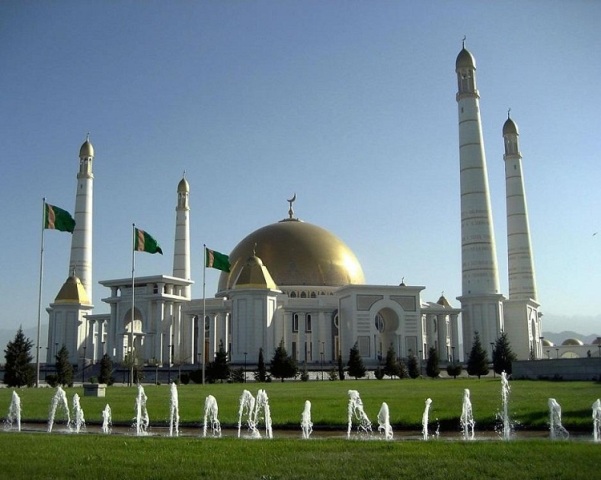Turkmenistan is a desert nation situated in Central Asia, bordering Caspian Sea. With this article, get to know some fun and interesting facts about Turkmenistan.
Facts About Turkmenistan
Turkmenistan is a country in Central Asia, which was once a constituent republic of the Soviet Union. It stands bordered by Afghanistan in the southeast, Iran in the southwest, Uzbekistan in the northeast and Kazakhstan in the northwest. Forming the southern border of the country is Caspian Sea, the largest enclosed body water in the world. Around eighty percent of the landscape of Turkmenistan stands covered by Karakum Desert. The climate of Turkmenistan is categorized as ‘subtropical desert’. It has four distinctive seasons, namely, winter, spring, summer and autumn. Turkmenistan’s economy is highly centralized; meaning more than half of the population is employed by the government. Only some industries and land are under private ownership. Cotton produce is extensive in this country; in fact it is the major crop here and half of the irrigated land is filled with cotton plantations. The country's natural gas reserves rank fourth in the whole world. However, lack of gas-pipeline routes out of the landlocked Country has made it almost impossible to export the abundant gas. Read on to gather more information on Turkmenistan. 

Image: David Stanley@flickr
Fast Facts
Continent: Asia
Area: 491,210 km2
Capital: Ashgabat
Population: 5,125,693 (2012 estimate)
Currency: Turkmen new mannat
Official Languages: Turkmen
Calling Code: +993
Type Of Government: Single-party State
Fun & Interesting Facts about Turkmenistan
- The official language of Turkmenistan is Turkmen, while Russian and Uzbek are also spoken there.
- Majority of the people in Turkmenistan are Sunni Muslims, followed by a Russian Orthodox minority.
- The main ethnic groups in Turkmenistan comprise of Turkmen, Russian and Uzbek.
- The currency of Turkmenistan is Pakistani Turkmen Manat.
- The capital of Turkmenistan is Ashgabat.
- Turkmenistan follows a ‘single party’ system.
- Turkmenistan became a part of the USSR, following the First World War.
- Turkmenistan gained independence from the Soviet Union on 27th October 1991.
- The name Turkmenistan has been derived from Persian language and means the "Land of the Turkmen".
- Tukmenistan ranks 112 in the world in terms of population.
- Turkmenistan ranks 5th in the world in terms of GDP growth rate.
- Turkmenistan has the second lowest population density in former Soviet Central Asia.
- The highest point in Turkmenistan is formed by Gora Ayribaba, at 3,139m.
- Karakum Desert covers almost eighty percent of Turkmenistan. It also forms one of the largest sand deserts of the world.
- Kugitang Reserve of Turkmenistan has a rock plateau imprinted with footprints of a dinosaur.
- Karakum Canal is one of the longest irrigation canals in the world.
- Amu Darya River, earlier known as Oxus, is the main river in Turkmenistan.
- Pastoral nomads have lived in Turkmenistan since the early times.
- The traditional nomad home in Turkmenistan is Yurta, a collapsible tent with a wooden frame.
- Turkmenistan has been known throughout the world, since centuries, for its Turkmen carpets.
- The Arvana dromedary camel and Akhal-Teke horse are bred in Turkmenistan.
- An Akhal-Teke horse forms part of the State Emblem of Turkmenistan.
- Merv, an ancient oasis city, served as an important trading center on the Silk Route between China and Europe.
- Natural gas, oil, petroleum products and textiles are the main industries of Turkmenistan.
- The literacy levels in Turkmenistan are 98 percent.
- The country has suffered three major earthquakes and one of its cities Ashghabat, was even destroyed in the 1948 earthquake. Today Ashghabat is the biggest and the capital city of Turkmenistan.
- In 2008, Turkmenistan unveiled her national flag which was 52.5 x 35 meters. Till date it is the world’s largest flagpole and finds mention in the Guinness Book of World Records.
- In Turkmenistan cotton is the major cropand the country is the world’s ninth largest cotton-producer.
- Turkmenistan’s natural gas reserve ranks fourth in the world.
- The ancient Turkmenistan was a part of the Persian Empire and the Turkmen people were actually pastoral nom ads who lived in portable tents, called ‘yurta’.
- Turkmenistan is renowned for horse breeding. The famous Akhal-Teke breed is raised in the southern region of the country. Horses of this breed were used for wars in the past, which are now are used for racing.
- The Akhal-Teke horse also represents the State Emblem of Turkmenistan.
- Carpets woven in Turkmenistan are famous throughout the world.
See also
More from iloveindia.com
- Home Remedies | Ayurveda | Vastu | Yoga | Feng Shui | Tattoos | Fitness | Garden | Nutrition | Parenting | Bikes | Cars | Baby Care | Indian Weddings | Festivals | Party ideas | Horoscope 2015 | Pets | Finance | Figures of Speech | Hotels in India : Delhi | Hyderabad | Chennai | Mumbai | Kolkata | Bangalore | Ahmedabad | Jaipur
- Contact Us Careers Disclaimer Privacy Policy Advertise With Us Lifestyle Sitemap Copyright iloveindia.com. All Rights Reserved.







